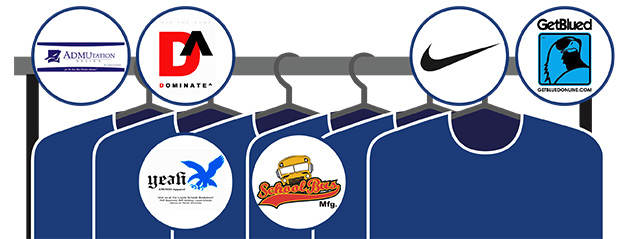
FOR YOUR WHITE AND BLUE. A sea of Ateneo fans, including Fr. Bienvenido Nebres, SJ, don Ateneo shirts as they cheer on for the Ateneo volleyball team in a UAAP game. Photo by Abram P. Barrameda.
The phenomenon of plastering the name of the Ateneo on shirts has been around for quite some time. Likewise, a number of jackets, lanyards and notebooks sold in the Loyola Schools (LS) Bookstore bear the name of the school, complete with the university’s insignia and stylized logo. It is a normal sight to see students wearing or using these products on campus.
However, the sight of an Atenean hoodie or varsity jacket in a place outside of campus and within a busy commercial area may be a bit off-putting to some individuals. Such brandishing of Atenean merchandise can easily be interpreted as an act of showing off. More than this, though, these Ateneo-branded products have also become available for purchase by anyone willing to pay, regardless of their degree of affinity with the Ateneo.
Hence, questions arise with the use of the Ateneo name on merchandise: Why bother marketing such outside of the university, as though expecting a different market to gravitate to it? Is there some social value or cultural capital attached to the name?
Beginning a business
Kirk Damasco (BS Mgt ’08), co-founder of prominent Atenean merchandise brand GetBlued, recalls that it was a competition that inspired him to undertake the business. “We started when we were in third year college during [Ateneo Marketing Association’s] Entrep Challenge. One of the challenges there was designing and selling of shirts.”
“My business partner and I saw the opportunity and we then set out to do our own,” he says, and explains that his colleague handles the creative aspects of the business. “My business partner, Ken Andrew Sy (BS Mgt ’08) is the one who designs the shirts.”
Today, GetBlued is selling merchandise in the LS Bookstore and in branches outside campus. Nevertheless, that Ateneo merchandising has been around long before the existence of GetBlued.
Damasco places a premium on tapping into different segments of the market. “Our target market is primarily Ateneans—students, alumni, faculty, staff.” He tries not to limit his target audience to those within the school. “Guests, visitors and fans of the Ateneo also buy our shirts and merchandise.”
Leloy Claudio of the Political Science Department recalls when the phenomenon started to emerge. “You notice that the spike in terms of Ateneo merchandise came alongside the Nebres regime,” he says, going on to elaborate that during Fr. Bienvenido Nebres, SJ’s tenure as the University President, it was his work with Gawad Kalinga (GK) that not only fostered unity among students on campus, but also strengthened university relations with external parties that could assist in GK initiatives.
“And it’s quite telling, for example, [that] they were turning Fr. Ben into a kind of icon. It wasn’t just Ateneo. It was his face being plastered on these things,” Claudio says.
Managing operations
LS Bookstore Director William Mallari explains that conducting the business of Ateneo merchandise is a matter of taking care of trademarks.
“What is unique to me right now is that I’m also part of the Business Affairs Office—it’s a new department of the university—and a part of the central administration wherein I’m also being tasked to help them with trademarks and sales. In fact, the mission is to get these XYZ corporations who would like to tie up with us and want to use these trademarks.”
He says that he is currently working with three such corporations, one of which is in charge of manufacturing footwear.
He clarifies, however, the limitation of his role in the administration. “It’s not my office who mans or provides or implements deadlines with regards to trademarks and Ateneo seals, et cetera.” These responsibilities fall under the jurisdiction of University Communications and Public Relations Office, he says.
The pros of the business
Mallari asserts that the responsibility of caring for trademarks is not merely a matter of business but of legacy—that for the university to maintain its reputation, it has to monitor its merchandise.
“The first and foremost objective of that department would be to make sure that the trademarks and seals of the Ateneo would be used correctly. We should protect what we have accomplished for the last 153 years. And the best way to do that is to protect our trademarks,” he says.
Though the profit gained from selling Ateneo shirts spikes during the UAAP season, Damasco believes that there’s more to the business of Ateneo merchandise than its obvious relationship with sports. He believes that the success of GetBlued, among other brands tied to the Ateneo, is bolstered by the excellence of the Ateneo in other fields.
“It is lucrative because Ateneo has such a rich tradition—in academics, politics, arts, entertainment, sports, et cetera. And this has been the source of pride for Ateneans and a reason for admiration from non-Ateneans,” Damasco concludes. “This is the reason why most, if not all Ateneans have a strong sense of love for the school, school spirit.”
Identity crisis
Claudio, however, has a different view on school spirit.
“That kind of thinking is not the kind of thinking that promotes dissent, because team players are not the dissenters. So actually, the Ateneo shirts, for me, [are] part of an overemphasis on team spirit,” he says.
He connects the idea of school spirit and the selling of Ateneo merchandise as a method of imposing formation and control, comparing school shirts to propaganda.
“I’m really afraid when anybody uses the word formation in this university. Because that usually means they have a particular agenda, to turn you into something that hews closely to a normative idea that was there to begin with,” he explains. “Yeah, so it’s part of that subtle mechanism. It’s like the cult of optimism, which is actually propagandic in value.”
He elaborates that the problem is not necessarily the commodification of the school’s name, noting too that the perceived elitism associated with the brand is more of a tangential issue.
“I think [the elitism is] perhaps marginal, because it’s there already—the elitist attitude… I think the damage, if there’s any damage, is the idea of a certain kind of Atenista [that is promoted]. It’s not necessarily related to commercialization. It’s related more to the idea of identity formation.”
Claudio opines that issues of formation and propaganda rooted in uncritical optimism hinder the cultivation of a culture that promotes dissent.
“Everybody who is opposing some kind of status quo is doing it from a position of negativity. Because who are the positive people? Who are the people who celebrate? The people in power, these are the people enjoying their power. They can go ‘I love Ateneo,’ ‘I love GK,’ ‘I put a picture of Fr. Ben on my shirt.’ That’s the more corrosive attitude I see here.”
Meanwhile, Mallari also points out that he does not buy into the idea of the elitist Atenean.
“Well for one, I’m not from this university. I’m the product of another university. So what you’re telling me now about elitism and et cetera—to be fair to the community I’m working with right now, I didn’t see that,” he says. “I will not go and make any programs that will make us or brand us as elitist. That will never be part of our program.”
Reconciling business
Though different individuals may share contradicting feelings regarding the issues underlying Ateneo merchandising, no one can deny how successful the venture has proven to be. For as long as Ateneo garners victories across many fronts and publicizes them, the Ateneo shirt will be around for a long time.
Mallari sees no issue in the business he directs.
“As long as I am reaching different segments of the market, inside of the university and outside of the university, I think I am doing a good job,” he says. “Whether elitist Atenista or school pride, I don’t know. But as far as I’m concerned, for the last five years that I’m connected to the university, I was able to reach different segments of the market, inside and outside the university.”
Though Claudio has his own take on Ateneo merchandise and the mentality it supposedly espouses, he does not fault the businesses themselves, noting that, after all, it is not necessarily the university that benefits monetarily but the companies involved.
“If the university [does] benefit, it’s sort of intangible. School spirit and stuff like that,” Claudio says. “I guess so long as these people are not tinkering with university policies or enforcing university policies, no, I don’t think there’s concrete harm.”
With reports from Nadine Y. Ramos
If you got it, flaunt it
The Ateneo name has been put to use by a number of brands over the past several years.
Infographic by Shanice A. Garcia








